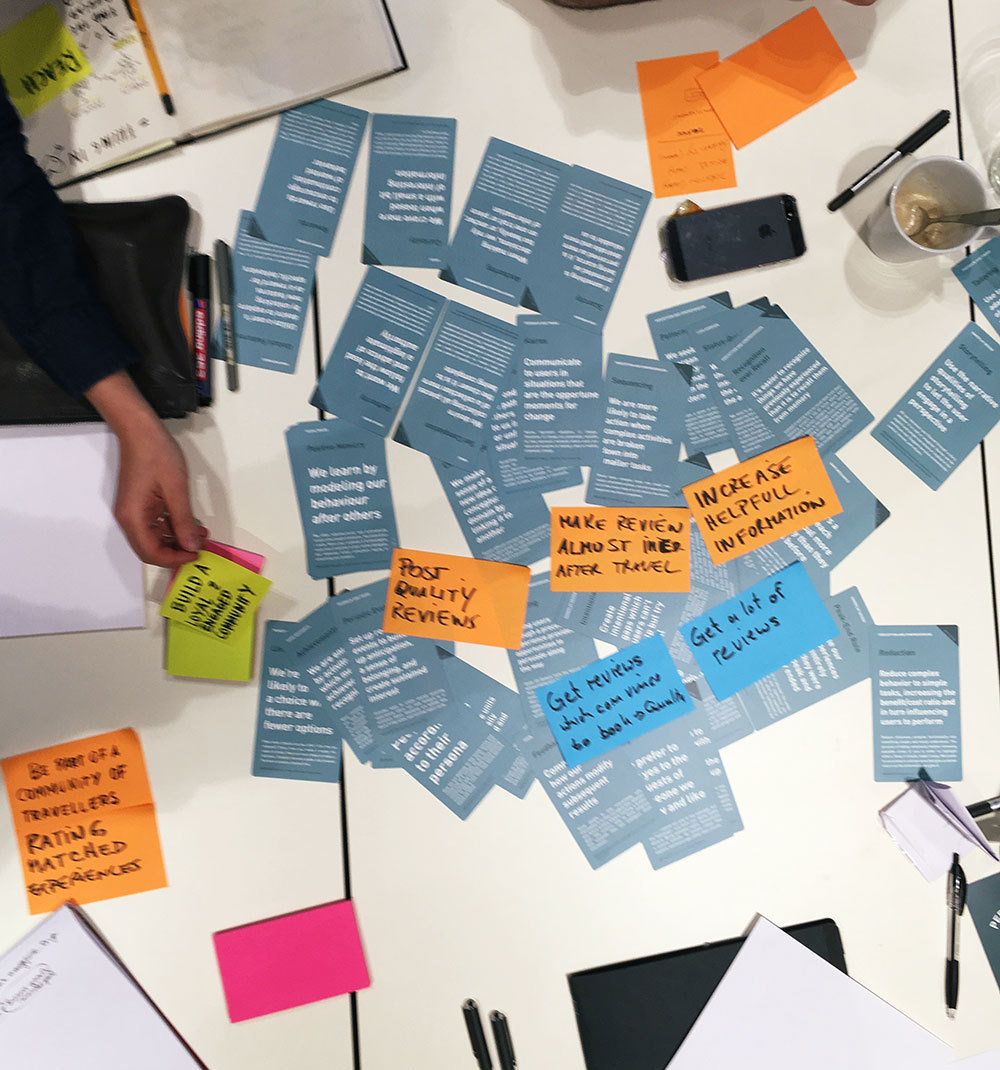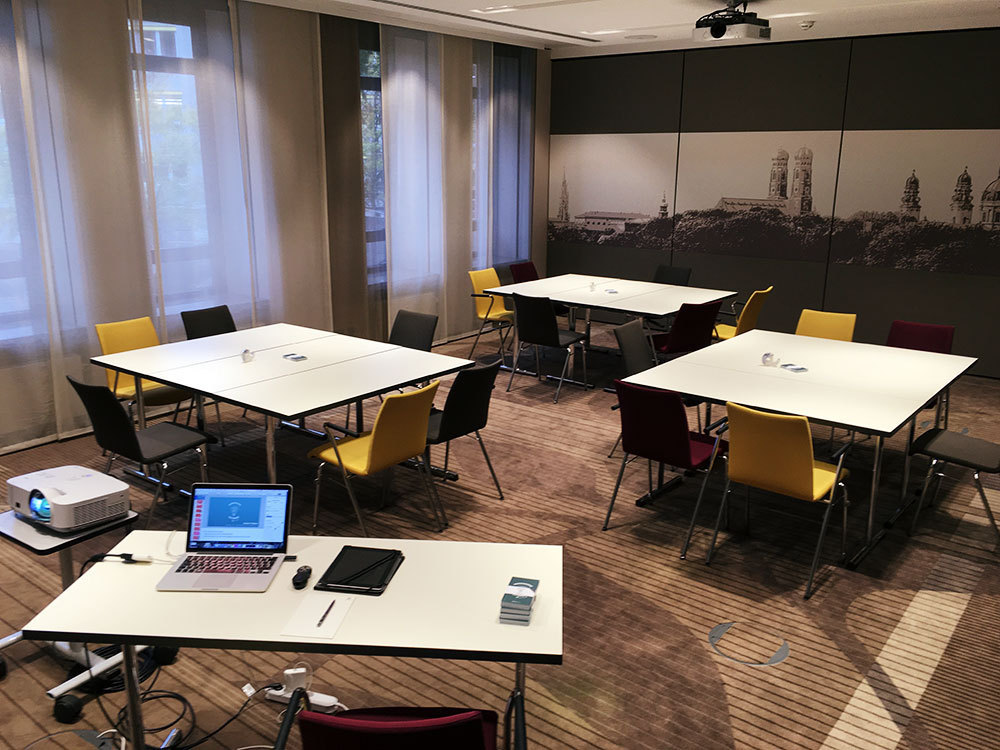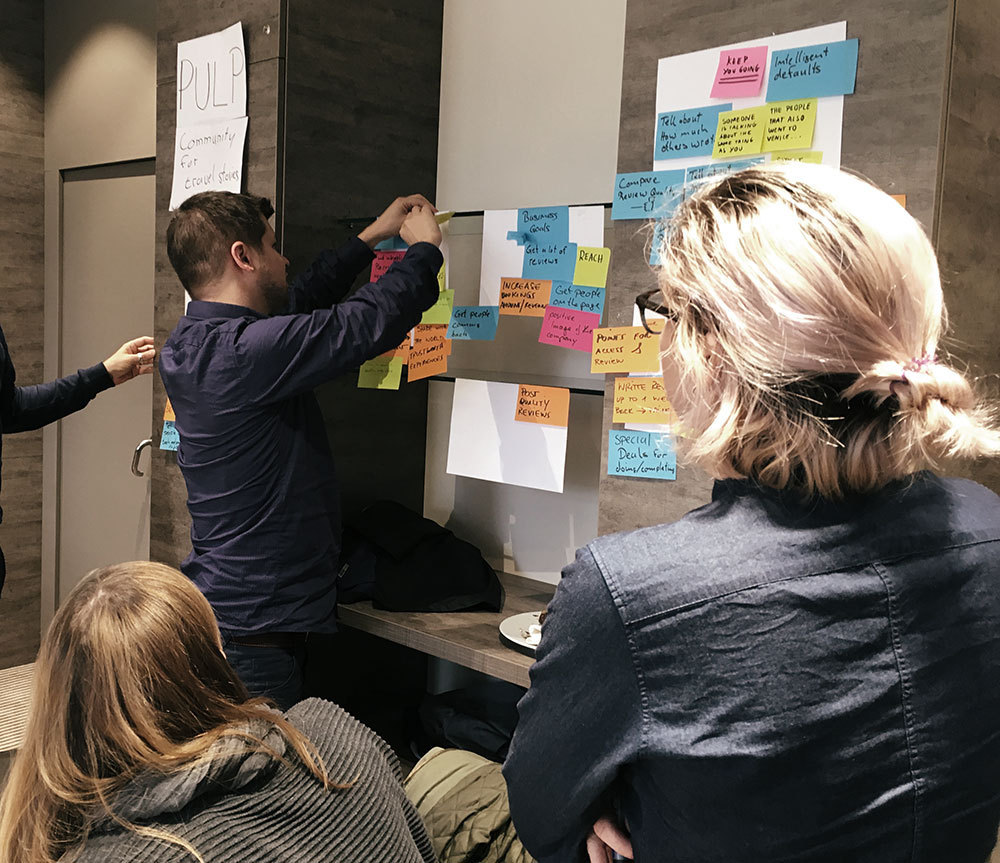I’ve spent the last 4 months prototyping and testing the Persuasive Patterns card deck, which will ship its pre-orders when spring comes. As I conducted test after test, I found the key to successful use of the cards being as much being a good facilitator as it is defining useful goals and conducting useful exercises.
Workshop facilitation tips
Let’s explore the first. Here are my best Workshop tips for becoming a seasoned workshop facilitator in the field of UX.
A good start
For you to be effective as a facilitator, it is vital that your audience is on your side. Establish trust by showing you have the merits to truthfully claim what you are preaching. Make the audience feel safe in what you want them to do and help them feel smart, by hinting where you want to go.
- Identify yourself. Build credibility by telling more about yourself – play on ethos. Let the audience know that you are the one to take them through the workshop and why you are the right one to do so.
- Identify your intent. Be open about your agenda and what you want partipants to do. Before you start any exercises, make sure overall goals and objectives of participants are aligned so that you can move people back within bounds if necessary.
- Identify what you are looking for. Make it easier for participants to contribute constructively to your overall objective, by explaining the end goal you want them to accomplish.
A good attitude
One of your core tasks as a workshop facilitator is get everyone relaxed and involved. Participants might be nervous about speaking up in an unfamiliar group and others will dominate discussions, leaving little room for the rest. Aim for an atmosphere among participants (and exercised by yourself) that is non-judgemental, relaxed and enjoyable.
If you plan group exercises, keep the size of each group small, so that people are more comfortable talking and interacting.
A good approach
A good approach to any workshop is to ensure four things are done throughout the workshop:
- Learn from the facts you gather. Analyze the information you’ve collected to identify patterns and insights.
- Look at what users really do. Observe people to discover what they do rather than what they say they do.
- Ask users to help. Enlist people’s participation to elicit information relevant to your project.
- Try it yourself. Create simulations to help empathize with people and to evaluate proposed designs.

Participants group brainstorm inspiration cards with post-it notes under one of many workshop tests for the Persuasive Pattern Card Deck.
A good facilitation
As a workshop facilitator, it’s your job to create an environment where everyone is comfortable enough to take risks and learn from what they experience. Demonstrate the attitude you want to see in them: you should laugh, so participants can laugh – you should be passionate, so participants can be passionate.
Switch roles as needed; from teacher, to exercise facilitator, to coach, to one-on-one instructor, to staying out of the way.
Stay out of focus
Participants come to learn. They can learn from each other as much as they can from you, provided that the atmosphere is relaxed and everybody feels safe. Participants will mimic your behavior, so be friendly and conversational so that participants will be as well. Invite participants with special skills to help more struggling participants.
Design exercises to make everyone feel comfortable talking and getting feedback from each other, as much from you. The beginner’s mistake is to center everything around yourself.
Your job as a facilitator has four important tasks:
- Suggest. Suggest and explain ways to apply principles throughout all stages of a project.
- Focus. Pull participants back into focus once straying away becomes unproductive.
- Remind. Remind workshop participants of various approaches.
- Restrain. Restrain yourself from being too dominant. Only interfere when it’s absolutely needed.
With those tasks in mind, your job is to steer the activities and reflections of your partipants by following these principles:
- “Yes and…”. Defer judgement and build on each other.
- New territory. Use analogous situations to take you to new territory.
- Use constraints. Constrain thinking to generate volume in ideas.
- Selection criteria. Define selection criteria up to choose the ideas you will take forward.
A good exercise
By following a set of heuristics when constructing exercises, you can enhance their effect dramatically.
Match promises to exercises
Each exercise should have a meaningful end-goal — or at least having an experience that help participants get closer to that goal. Let participants know what you believe they will have achieved, or experienced, by the time the exercise is over. Use that description to help describe the overall promise of the workshop and its exercises. If your workshop description has a promise which doesn’t map to specific exercises, either change the description or your exercises. You’ll find you need to limit your promises, which is good and realistic for everyone.
Use the triad: explain, exercise, debrief
It helps constructing both your workshop and exercises in unites of three.
- Explain. Explain how to do the exercise. When it makes sense, also why it is important.
- Exercise. Let participants carry out what you set them to do. Remain out of the focus as the exercise goes on (wander around and help participants one on one).
- Debrief. Present, reflect, connect
- Presentation. Let participants showcase their work (rather than your own) to other participants. Ask questions that will reveal your insights and observations and that in turn will invite participants to share their own.
- Reflect. Let participants reflect on the exercise that they just did. What did they get out of it? Where and how did they get stuck. What was fun, hard, or frustrating, and what did they learn? Did they see new perspectives that would be interesting to pursue?
- Connect. Connect the product of the exercise to what you have previously learned and any activities coming up.
A good team
The power of cross-functional teams
In the Medici Effect, Frans Johansson explains how brining together people from diverse industries and functional domains will inspire innovation: “When you bring together diverse teams and perspectives, you have the ability to create an exponential increase in ideas”. He continues to claim that “all new ideas are combinations of old ideas, but not all idea combinations are created equal”. When changing perceptions, things can start to make sense (while you’re doing something else).
Smaller teams over bigger teams
Smaller teams allow for everybody to come forward. The larger you make a team, the easier it will be for people to hide and let more dominant members take charge. If you know the personality of your participants beforehand, try to distribute dominant participants in separate groups.

At my workshop for the Push Conference, participants were divided into 3 groups, which battled each other throughout the day.
A good momentum
As humans, we fatigue after about an hour, so try to keep your sprints shorter. 45 minutes is often seen as a good rule of thumb. Start with smaller things to create a feeling of early success and build to larger projects as the workshop goes on.
Take breaks regularly. Let users stand up or walk out to get refreshments as this will help their heart rate go up and in turn get their energy back. A rule of thumb is to let participants move around at least every hour or two. Sometimes, it’s constructive to let participants check their email on their phone – see it as a breather that brings in energy to the next exercise.
A good parking lot
Whenever participants stray off to topics that are related, but doesn’t provide value for the workshop, ask them to fill out a post-it note and place it in the “parking lot”. The parking can be a square painted on a whiteboard, flipchart, or a particular window or wall.
Using a parking lot is a great way to postpone concerns to after the workshop. As participants add items to the parking lot, it is with the promise that they will all be addressed in the end of the workshop. Chances often are, that once they have understood the entire topic fully, items added aren’t all relevant anymore.
A good tool list
Bring things to write on. Switching between verbal and written communication can help you switch modes from being productive to creating perspective and understanding.
Use post-its
Common challenges in workshops includes dominant participants leaving little room for other participants, discussions that stray off or become too detailed. Here, post-its can be a phenomenal tool as they let participants put down their thoughts individually without disturbances. This allow room for thoughts by those less dominant as well as the dominant. Combine post-it notes with time-boxed brainstorms with succeeding presentations.
Have a whiteboard or flipchart in the room
You might want to use it for yourself, but more importantly, allow participants to break of explaining something bigger, drawing on a board. Digital whiteboards won’t do it as they might break or take several minutes to boot.

Use post-its to group ideas into separate chunks to explore similar ideas that can build on each other.
A good test
Test your exercises beforehand. Developing an exercise which is valuable for the majority of participants is challenging. The best workshop instructors test their exercises over and over again to final perfection – learning how to adapt it along the way to specific types of audience.
Every participant is different. They bring in different perspectives, backgrounds, motivation, and capabilities. This is why you will want to build in ways to make the required skill level smaller og bigger, on the spot. Be ready to make a workshop exercise more challenging for individual participants, if they feel bored – or easier if they feel anxiety.
Do a dry run of each exercise, if not the entire workshop – for free, if needed, with the kind of people your final workshop will be for. After a few runs, you will find that your initial plan has been greatly altered.
A good checklist
Build a workshop checklist. As you iterate and test exercises and the workshop format, the amount of things to bring and remember grow as well. Make notes of it all and convert it to a checklists. Make a list of what to bring (markers, pens, post-it notes, flip-charts, tape, ideation cards) as well as quirks and things to remember to get right for each exercise along the way.
A good followup
Communicate decisions
Make a plan for how you will communicate decisions reached during the workshop. Will you send out an email to everybody, put it up on the intranet, or hang up the poster that was the end product of your group exercises?
Get feedback to improve the next workshop
Another part of your followup plan is to ask for feedback. Send out a questionnaire to your workshop participants at the end of the event, and give them plenty of opportunities to share their experience.
Keep the momentum
Workshops are great for stirring up new ideas and setting things in motion. However, for the effect to last, an effective followup strategy is needed. Common followups are sending slides, work sheets, or giving out tasks or homework for a possible second followup workshop. You might also want to a small list of the best books or other resources participants are likely to need.
The perfect UX brainstorm tool
I’ve learned these workshop tips along the way as I was beta-testing my latest project: The Persuasive Pattern Card Deck. The cards will ship in the spring of 2016 – until then, you can pre-order the cards. Update: The cards have launched!